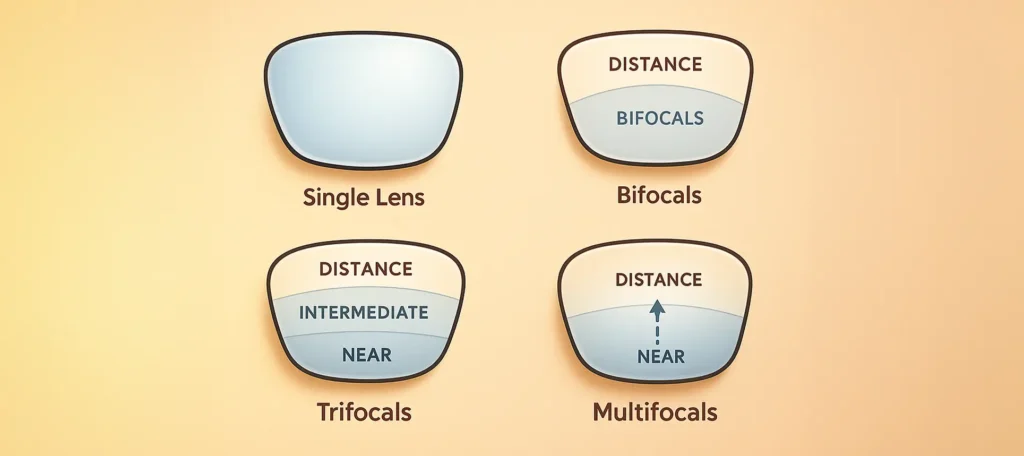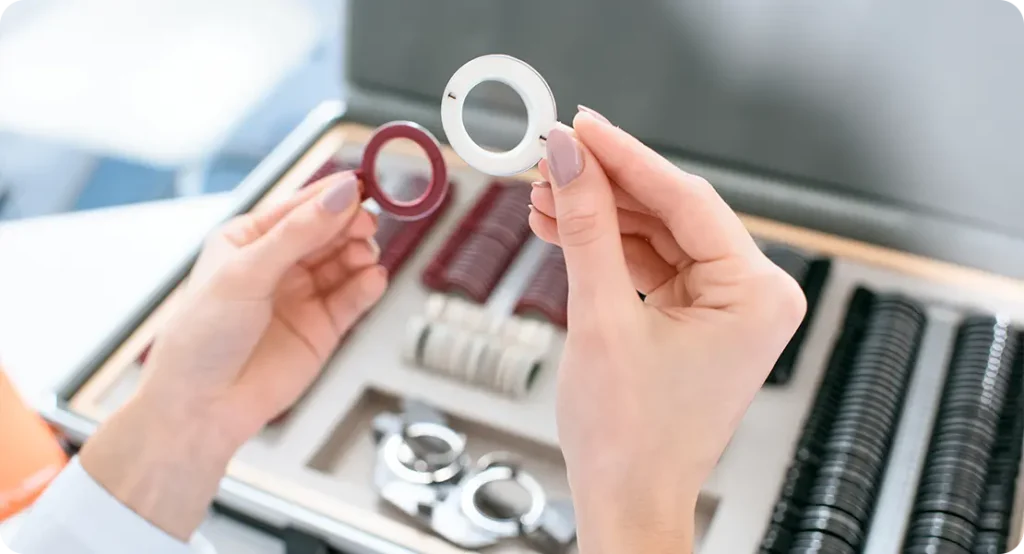If you’re considering cataract surgery, one of the most exciting things you’ll hear about is the choice of intraocular lens (IOL) you can have. Not that long ago, patients had only a basic option: the standard monofocal lens, which gives clear vision at one distance. But in the last decade, the field has exploded with innovations. Today, when someone asks “what is the newest lens for cataract surgery?”, the answer is that there are several cutting-edge options — from enhanced depth-of-focus lenses to light-adjustable implants that can be fine-tuned after surgery.
This article is designed to walk you through the latest advances so that you know what’s out there, how the different lenses compare, and what questions you should be asking your surgeon.
Why the Lens You Choose Matters

When your cataract is removed, your surgeon replaces your cloudy natural lens with an artificial one. That lens stays in your eye for life. Unlike glasses or contact lenses, you don’t swap it out every year — it’s a one-off decision with long-lasting consequences.
The lens you choose will affect not just how clearly you see, but also how you use your eyes in everyday life. Will you still need reading glasses? Will night driving be comfortable? Will you be able to work at a computer without straining?
That’s why the “newest” lenses are generating so much interest: they’re designed to give you greater freedom, fewer visual side effects, and more tailored outcomes than the older options.
The Traditional Option: Monofocal Lenses
Let’s start with the benchmark. A monofocal lens is the type that’s been used for decades. It’s reliable, affordable, and gives excellent vision at one distance — usually far away. If you have a monofocal lens set for distance, you’ll probably still need reading glasses for near work and maybe intermediate glasses for things like using a laptop.
Many people do perfectly well with monofocals, especially if they don’t mind wearing glasses for reading. But the limitation is obvious: your vision is corrected only at a single distance. That’s where newer lens technologies step in.
Correcting Astigmatism: Toric Lenses

Some people have astigmatism, where the eye is more rugby-ball shaped than round. If this isn’t corrected during cataract surgery, your vision may still be blurry even with a monofocal lens. A toric lens is a special version of a monofocal that also corrects astigmatism.
Toric lenses have been around for years and are now widely used, but they remain an important step forward compared with standard monofocals. They show how lens designs have become more personalised, addressing specific visual needs.
Multifocal and Trifocal Lenses
The next big advance was the development of multifocal lenses. These are designed with rings or zones that split light to create more than one focal point. That means you can see clearly at more than one distance.
- Multifocals usually give good vision for far and near.
- Trifocals add a third range — intermediate — which is particularly useful for computer work and dashboard viewing.
The trade-off is that because the lens splits light, you may notice halos or glare around lights at night, and sometimes a slight reduction in contrast. Still, many patients love the freedom from glasses that trifocals provide.
Extended Depth-of-Focus (EDoF) Lenses
EDoF lenses are another innovation designed to overcome some of the drawbacks of multifocals. Instead of creating separate focal points, they stretch the focus into an extended range. This gives smoother vision from distance through to intermediate, and often a bit of near.
The advantage is fewer halos and glare compared with multifocals, though you may still need glasses for fine print. For people who spend a lot of time on computers or want balanced vision without too many side effects, EDoF lenses are very appealing.
Accommodating Lenses

Another approach is the accommodating lens. This type is designed to shift slightly inside the eye when you try to focus, mimicking the natural lens. In theory, this should give you a continuous range of vision.
In practice, accommodating lenses have shown mixed results. They can provide some range, but often not enough to eliminate glasses altogether. Researchers are still refining these designs, so it’s an area to watch for the future.
Light-Adjustable Lenses
One of the most exciting developments is the light-adjustable lens (LAL). Unlike all the other lenses, which are fixed at the time of surgery, this one can be fine-tuned afterwards.
Here’s how it works: the lens is made of a special photosensitive material. After surgery, once your eye has healed, your surgeon uses a controlled light treatment to adjust the lens power. You might need a few adjustment sessions, and once you’re happy, the lens is “locked in.”
This is a game-changer because it takes away much of the guesswork. Even with the best measurements, predicting exactly how your eye will heal isn’t perfect. A light-adjustable lens allows that final adjustment to give you sharper, more personalised vision.
Newest Lenses
So, what actually counts as the “newest” lens right now? The answer is that a handful of models have either been launched or approved very recently, and they represent the cutting edge of intraocular lens design. These aren’t radical departures from what we’ve seen before, but they are meaningful refinements that push the boundaries of what’s possible with artificial lenses. Let’s look at three of the key names you’re most likely to hear about in 2025 and over the next few years.
TECNIS Odyssey is probably the most talked-about of the group. It’s part of Johnson & Johnson’s TECNIS platform, which has a long track record of producing high-quality lenses. Odyssey is marketed as a “full visual range” lens, meaning it’s designed to give you continuous vision from distance to near without the abrupt steps of older multifocals. Early reports suggest it performs particularly well in low light, with better contrast sensitivity than many trifocal designs. That makes it attractive to patients who drive a lot at night or struggle in dim conditions. Another selling point is that Odyssey seems to produce fewer halos and glare, which are often the biggest concerns with premium lenses.
PanOptix Pro is the newest evolution of the PanOptix trifocal lens, which has been one of the most widely implanted premium IOLs worldwide. The original PanOptix was already popular for providing strong distance, intermediate, and near vision. The “Pro” version builds on this by fine-tuning how light is distributed through the lens. The goal is to give crisper contrast and reduce visual side effects like glare, particularly under challenging lighting. It’s not a complete reinvention, but for patients who liked the sound of PanOptix but worried about side effects, PanOptix Pro could be a reassuring option.
Envista Envy is another recent addition that has been designed with everyday practicality in mind. Its main focus is consistency across different lighting conditions, which is something that many patients don’t realise can be a challenge until after surgery. For example, some lenses perform beautifully in daylight but aren’t as strong in dim indoor lighting or at night. Envista Envy tries to smooth out those differences so that your vision feels stable and comfortable wherever you are. That makes it particularly appealing if you don’t want to notice sudden changes in clarity depending on the environment.
What’s important to understand is that all of these lenses are evolutionary rather than revolutionary. They’re based on established technologies like trifocal optics and extended depth-of-focus principles, but they refine them with smarter light distribution, better contrast handling, and improved tolerance to visual imperfections. In other words, they represent the next generation of lenses that aim to address the most common complaints patients have had with earlier models.
For patients, the takeaway is this: the “newest” lenses aren’t necessarily about unlocking an entirely new way of seeing, but about improving comfort, reducing side effects, and making the benefits of premium IOLs accessible to more people. These incremental but meaningful improvements mean you’re more likely to have a smoother visual experience and a quicker adjustment period compared with earlier premium lenses.
Side-by-Side Comparison of the Newest Lenses
| Lens Name | What It Offers | Key Benefits | Possible Trade-Offs | Best Suited For |
| TECNIS Odyssey | A “full visual range” lens designed for seamless vision from distance to near. | Strong contrast sensitivity, particularly in low light; fewer halos and glare than many trifocal lenses; continuous range of focus. | Still relatively new, so long-term data is limited; availability may be restricted at some centres initially. | Patients who drive at night, want smooth vision at all distances, and prefer fewer side effects. |
| PanOptix Pro | The next-generation version of the popular PanOptix trifocal. | Clear vision at distance, intermediate and near; refined light distribution for sharper contrast; improved comfort compared to earlier trifocal designs. | As with all trifocals, halos and glare are still possible; best performance depends on careful alignment by the surgeon. | People wanting maximum independence from glasses, especially for reading and computer work. |
| Envista Envy | A newly designed lens with an emphasis on performance across different lighting conditions. | Vision that remains stable whether in bright daylight, indoor lighting, or at night; consistent clarity reduces “surprise” changes between environments. | May not provide quite the same fine near detail as a trifocal; longer-term studies are still emerging. | Patients who want balanced, reliable vision for everyday life without worrying about lighting changes. |
In simple terms:
- Odyssey is about continuous, low-side-effect vision at all distances.
- PanOptix Pro is about maximum spectacle independence with refined optics.
- Envista Envy is about consistency across lighting conditions for day-to-day comfort.
Materials and Coatings
It’s not just about optics. The newest lenses also use improved materials and surface designs. These can reduce problems like “glistenings” (tiny fluid pockets that can scatter light) and lower the risk of posterior capsule opacification (a clouding behind the lens that sometimes develops after surgery).
Some lenses now include advanced filters that block harmful UV or violet light while letting in the good wavelengths needed for colour perception and contrast. These subtle improvements help preserve quality of vision in the long run.
Choosing the Right Lens for You
With so many options, how do you decide? Here are some questions to ask yourself:
- Do I want to be as glasses-free as possible?
- How much night driving do I do?
- Can I tolerate the possibility of halos or glare?
- Do I need especially sharp near vision for hobbies or work?
- Am I willing to attend multiple follow-up visits for a light-adjustable lens?
Your surgeon will also look at factors like the health of your retina, the shape of your cornea, and whether you have other eye conditions. The newest lens may not always be the best choice if your eye isn’t suited for it.
The Future of Lenses
Looking ahead, researchers are working on “smart” lenses that can adapt dynamically, wavefront-guided lenses tailored to your individual optical fingerprint, and materials that resist ageing changes. We’re not quite there yet, but the pace of innovation suggests that cataract surgery will only become more personalised in the coming years.
Frequently Asked Questions
1. Is the newest lens always the best choice?
Not necessarily. The newest lens often brings exciting features, but that doesn’t mean it’s the right fit for every patient. Some people’s eyes are better suited to proven monofocal or toric lenses, especially if there are underlying conditions like macular degeneration or glaucoma. The best option is always the one that balances new technology with safety, predictability, and what will genuinely support your lifestyle. Your surgeon’s guidance is crucial here, because they can match the strengths of each lens to your specific needs.
2. Will a new lens mean I never need glasses again?
The promise of being glasses-free is one of the biggest draws of premium lenses, but it’s important to be realistic. Trifocal and extended depth-of-focus lenses can reduce your reliance on glasses a great deal, and many people hardly ever need them afterwards. That said, there will always be situations — like reading very fine print, dimly lit conditions, or prolonged close-up work — where glasses may still be helpful. The aim is usually to give you maximum freedom, not a 100% guarantee.
3. Are the side effects of newer lenses less noticeable?
Many of the latest lenses are designed specifically to reduce problems like halos, glare, and reduced contrast. In practice, this means that more patients can drive comfortably at night or enjoy clearer vision across different lighting conditions. Still, no technology can completely remove the risk of side effects. Some people are naturally more sensitive to visual artefacts, while others hardly notice them at all. It’s worth having a detailed chat with your surgeon about how common these effects are with each type of lens.
4. How long do these lenses last?
Once an intraocular lens is implanted, it’s designed to stay in your eye for life. The material doesn’t wear out or degrade in the same way that glasses or contact lenses do. What can happen is that the capsule which holds the lens may become cloudy over time, a condition known as posterior capsule opacification. This isn’t a failure of the lens itself and can be quickly treated with a simple outpatient laser procedure. So the lens itself should serve you for decades without issue.
5. What makes light-adjustable lenses different?
Light-adjustable lenses stand out because they allow fine-tuning after surgery. All other lenses are fixed the moment they’re implanted, but a light-adjustable lens can be adjusted using a controlled light treatment over a series of visits. This gives you and your surgeon the chance to get as close as possible to your ideal vision once your eye has healed. It’s especially helpful for people who want precision or who have had previous eye surgery that makes lens calculations more complex.
6. Do these lenses cost more than standard ones?
Yes, advanced lenses usually come at a higher cost, particularly if you’re choosing them privately. This is because they involve more complex design, sometimes more surgical planning, and often extra follow-up visits. In the NHS, monofocal lenses are the standard option and are covered as part of the procedure, while premium lenses are generally only available through private providers. If you’re considering a newer design, it’s worth asking your clinic for a clear breakdown of the fees so you know exactly what’s included.
7. Can I have a new lens if I’ve had laser eye surgery before?
It is possible, but it requires extra care. Previous laser eye surgery changes the shape of your cornea, which can make it harder to predict how a new intraocular lens will perform. Modern diagnostic equipment has improved the accuracy of these measurements, and some of the latest lens designs are more forgiving in eyes with complex optics. Your surgeon will run detailed scans and may recommend certain lenses over others depending on the stability of your cornea.
8. Can I change the lens later if I’m unhappy?
In some cases, yes, but it isn’t straightforward. Lens exchange is more complex than the original cataract operation and carries additional risks, especially if a lot of time has passed since the first surgery. That’s why surgeons encourage careful decision-making up front, so the chance of needing an exchange is minimised. Some of the newest lenses, like the light-adjustable design, reduce this worry because adjustments can be made without replacing the lens entirely.
9. How quickly will I adjust to a new lens design?
Adaptation times vary. With monofocal lenses, your brain usually adapts within days. With trifocals or extended depth-of-focus lenses, it can take longer as your brain learns to blend multiple focal points. Some people settle within weeks, while others need a few months before the vision feels completely natural. The good news is that most patients do adjust successfully, but it helps to go into surgery knowing that a little patience will be needed during the early stages.
10. Should I wait for even newer lenses in the future?
It’s tempting to wait for the next big advance, but cataracts won’t wait for technology to catch up. If your vision is already interfering with daily life, postponing surgery could reduce your quality of life and even your safety. Today’s lenses are already highly advanced, with options that suit most lifestyles. While new designs will continue to arrive, the best decision is usually to treat cataracts once they start affecting your independence rather than hold out for something that might be years away.
Final Thoughts
Cataract surgery has always been life-changing, but the choices available in 2025 make it more personal than ever. The newest lenses aren’t about simply removing the blur — they’re about shaping your vision in a way that matches your lifestyle. Whether it’s the seamless, low-glare vision of the TECNIS Odyssey, the glasses-free independence of PanOptix Pro, or the day-to-night consistency of Envista Envy, these advances are designed to give you more freedom and fewer compromises.
That said, the “newest” option isn’t automatically the best one for everyone. The right lens for you depends on the health of your eyes, your visual priorities, and what you want from life after surgery. Some people will be happiest with tried-and-true monofocals, while others will embrace the possibilities of premium lenses or even the fine-tuning potential of light-adjustable technology.
The most important step is an honest conversation with your surgeon. Talk about your lifestyle, ask about side effects, and make sure you understand the trade-offs. A skilled surgeon can guide you through the options and help you decide which lens truly fits you — not just on paper, but in the way you’ll use your eyes every day.
At the end of the day, whatever lens you choose, cataract surgery can restore clarity, brighten colours, and give you back confidence in your vision. And with today’s technology, you have more choice than ever before in how that clarity looks and feels.
If you’d like to explore your options further, you can book a consultation with our team at London Cataract Centre.
References
- Johnson & Johnson (2024) Johnson & Johnson Vision launches TECNIS Odyssey intraocular lens offering cataract patients precise vision at every distance. Available at: https://www.jnj.com/media-center/press-releases/johnson-johnson-rolls-out-new-tecnis-odyssey-next-generation-intraocular-lens-offering-cataract-patients-precise-vision-at-every-distance-in-any-lighting (Accessed: 24 September 2025).
- de Silva, S.R., Evans, J.R., Kirthi, V., Ziaei, M. and Leyland, M. (2016) ‘Multifocal versus monofocal intraocular lenses after cataract extraction’, Cochrane Database of Systematic Reviews, (12), CD003169. Available at: https://www.cochranelibrary.com/cdsr/doi/10.1002/14651858.CD003169.pub4/full (Accessed: 24 September 2025).

